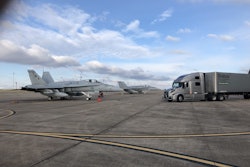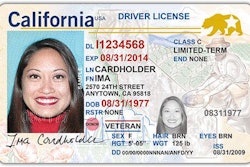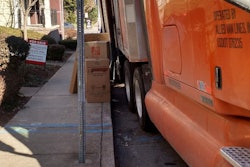 Independent owner-ops Mandi Jo and William Pinheiro (and their dog, Luka)
Independent owner-ops Mandi Jo and William Pinheiro (and their dog, Luka)Much has been made over the years about the variability in procedures when it comes to entering to deliver a load to one of the untold number of military installations across the country. Independent team William and Mandi Jo Pinheiro, hauling platform freight, got a reminder of that in June at Naval Base Kitsap’s Bangor, Washington, installation along the coast.
Mandi Jo took the picture above in the aftermath, as the Pinheiros waited outside the entry gate for a driver from a local tow company to return with their truck and trailer from inside. “Weird feeling,” she quipped with her post as the couple tried to make the best of the downtime. “But hey, it’s not raining so that’s good.”
Days before, they’d put in calls to the sponsor contact within the base they had from the broker/shipper they were hauling for to relay their timing on the load and etc. “The sponsor never answered his phone,” she says.
The Pinheiros updated their CDLs to Idaho’s “Star Card,” new Real ID law-compliant licenses that, they thought, would be sufficient to gain access to most military locations they might deliver to, including bases like this. (Generally, starting in October next year, Real ID-compliant licenses — all with a star on their front — will be required documentation at airport security for travelers and all military installations for visitors, unless supplemental forms of ID, such as a passport or birth certificate, are also available.)
Rules for trucking contractors at military bases can vary, though, as Naval Base Kitsap’s Deputy Public Affairs Officer Lonnie Collier III reiterated. “The requirements for entrance into government facilities is done on an installation-by-installation basis. What can get you on one base may not be adequate to get you on another. In this particular case, the Idaho Real ID was not sufficient for the drivers to get on base.”
Collier emphasizes, too, that requirements can change from time to time depending on what’s happening at a particular location — in this case, for instance, whether a ship is there or not. He adds that when various entities within the base make an order that needs to be trucked in, “the requirements to get on base are sent with that order. “In many cases, those requirements are not delivered to the actual driver, so they do not have the required paperwork to get on base.”
If you have any doubt on your way to a base or other installation, and in particular Naval Base Kitsap, a call to the Visitor Control Center is recommended, Collier adds. Naval Base Kitsap, too, is working on redesigning its website “to show what information is needed to gain access on this particular installation” for different classes of visitor.
Paperwork the Pinheiros had been given by their broker about access policies at this particular base, though, suggested they’d be OK at first glance. Pinheiro notes it used the “enhanced driver’s license” language when it noted forms of acceptable ID.
That’s a reference, however, not to basic Real-ID-compliant licenses like the Pinheiros’ but to RFID chip-enabled licenses issued in some Northern Border states to grease the skids crossing into Canada and back.
“We check in and we hand them our superpower driver’s license from Idaho,” Pinheiro notes, and the guard notes that because it didn’t have the RFID chip the border enhanced licenses all do, “it wasn’t good enough” for the base in this case. Staff handed over a list with all the tow companies nearby — “that was our only option,” other than to leave and come back with a Passport, a birth certificate,or other acceptable forms of ID.
They untarped the load while they waited in hopes of expediting the whole process.
Rate for the company they ultimately contracted with to borrow their truck for a little more than an hour: $240 per. “It cost us $276 worth of his time,” Pinheiro says. “The tow guy … was totally used to truck drivers not wanting to hand over the keys,” and generally was a pleasure to deal with. As they chatted with him, he noted this happened at this particular base “20 times a day,” she says.
It happened to the driver ahead of them, too, loaded with no more than a pallet and a half. Unfortunately for him, he was still waiting when the Pinheiros’ truck returned and they hit the road.
Bottom line headed to any military installation: Double-check with the base itself, whether with the sponsor contact or, if unsuccessful, visitor control, as Collier emphasizes.
It might save you $240 or more worth of a tow driver’s time.









